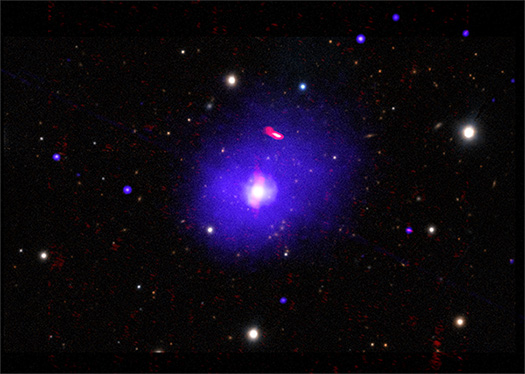Chandra Unveils Rotation Speed of One of the Most Massive Black Holes Ever Seen

Julia Sisk-Reynés
Our guest contributor is Julia Sisk-Reynés, the leader of a new black hole study that is the subject of our latest press release. Julia is a second-year PhD student at the Institute of Astronomy at the University of Cambridge, UK, where she is a member of the X-ray group working mainly with Prof. Chris Reynolds and Dr. James Matthews. Her primary focus is on constraining beyond the Standard Model Physics – in particular, axion-like particles (ALPs)- with X-ray observations of cluster-hosted active galaxies. The team have recently set the tightest limits to-date on the coupling of very light ALPs to electromagnetism with Chandra X-ray observations of the cluster-hosted quasar H1821+643. Julia came to Cambridge in 2020, straight after graduating from the University of Manchester with a master’s degree in physics. Amongst others, she did a project on assessing the sensitivity of the DarkSide-20k liquid argon experiment in Gran Sasso, Italy, to direct dark matter detection.
Black holes are one of the most tantalizing objects in the Universe. By 1915, Einstein’s Theory of General Relativity had introduced the notion that the gravity of black holes is so strong that they can distort the space-time around them … to the point where even light close to the black hole cannot escape! More recently, astronomers have gathered evidence that most – if not all – galaxies emitting lots of light at the center (also called active galactic nuclei or AGN) host a very massive black hole at their core. It is known that the properties of AGN and their central black holes are often linked. For example, the heavier the AGN, the heavier its host black hole. Therefore, the formation, growth, and evolution of black holes over time and their connection with the properties of their host galaxies are fascinating topics for astronomers to pursue.
Astronomers classify black holes into three groups, depending on their mass. Firstly, stellar-mass black holes, thought to form from the gravitational collapse of a star, weigh a few to a few tens of times the mass of the Sun. Then, we have a class of black holes of unknown origin which range from hundreds to tens of thousands of Suns, often referred to as “intermediate mass” black holes. A gravitational wave event detected in 2019 by the LIGO and VIRGO collaborations confirmed the existence of a black hole in this second category. Finally, supermassive Black Holes (SMBHs) weigh between millions and billions of Suns. While their origin is still debated, what we do know is that accretion, that is, the feeding of gas onto such black holes, is responsible for the X-ray emission coming from the AGN that surround them.
The accretion of gas onto the SMBH also fuels the emission of strongly beamed material that can heat up the cold interstellar gas that would otherwise form stars. A way to learn about the properties of SMBHs is by studying how fast they rotate, that is, by measuring their spin as a function of mass. In fact, at a fundamental level, black holes can be described by only these two quantities: mass and spin.
By the end of the last decade, X-ray observations of tens of AGN with SMBHs of different masses had provided evidence that lighter black holes (weighing between about a million and ten million Suns) had been observed to mostly rotate at their maximum speed (very close to the speed of light!), while it seemed that their heavier peers were rotating at more moderate rates. Recently, our team found evidence that a very high-mass SMBH is rotating at around 60% of the speed of light. This is exciting both because there have not been many studies on how fast these massive SMBHs spin, and because this may suggest that the heaviest black holes accrete material in different ways to their smaller-mass cousins.
In our work, we used almost seven days of observations with NASA’s Chandra X-ray Observatory, which were taken 21 years ago, of a very luminous AGN which astronomers named H1821+643, due to its location in the sky. This massive galaxy is 3.4 billion light years away. The SMBH at its center was estimated to be between 3 and 30 billion times the mass of the Sun, compared, for example, to the 7 billion Suns the black hole at the center of M87* weighs. M87* is the first galaxy that the Event Horizon Collaboration reported an image of back in 2019, which, in total, is a hundred thousand times less luminous than H1821+643 – though 63 times closer!
We analyzed the Chandra spectrum of H1821+643 carefully, that is, the amount of energy received from the galaxy per unit area on the detector, as a function of wavelength, finding that this spectrum can be best described if the black hole is rotating at a modest rate. Excitingly, this may be the most accurate spin measurement for such a massive black hole.
Our result differs from most spin measurements of SMBHs weighing from one to tens of million Suns since they have mostly been found to have high or maximal spins. Other authors have suggested that this could be because the gas being fed onto these lighter black holes may spiral in an 'orderly' way, that is, such that it rotates in alignment with the direction of rotation of the black hole itself. However, this may not be true for black holes heavier than a few hundred million Suns if they grow by pulling in material from all random directions. Another possible explanation for the moderate spin of these very massive black holes is that they could originate from the merger of lighter mass SMBHs, as has recently been suggested by computational simulations of structure formation in the Universe across cosmic time.
Overall, our work provides an accurate spin measurement of one of the most massive black holes ever observed and signifies an exciting step forward in our route to uncover how the most massive black holes in the universe grow.

